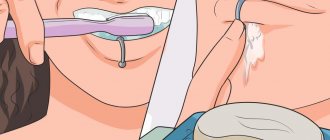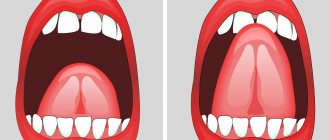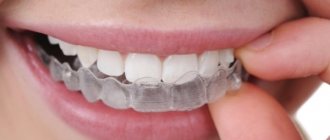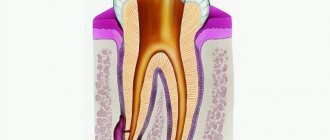Injury
In case of traumatic injury, a kind of capsule is formed in the oral cavity, which is filled with secretions and pathogenic microorganisms. The lights enter the food cavity.
Trauma can cause the gland to become clogged with saliva, leading to the formation of a cyst.
It is not difficult to get such damage; it often occurs as a result of:
- Contact with sharp, chipped teeth.
- Rough food, various metal objects.
- If you hit the jaw, you can injure the mucous membrane of the mouth and tongue.
- In contact with reagents and hygienic devices.
You can get injured while taking medications, eating food, or using dental floss. As a result, the mucous membrane swells and secretions accumulate in it. It can be transparent, bloody or bloody.
The capsule or bubble may burst on its own, without medical intervention. But education, in case of poor immunity, disruption of the body’s natural protective functions, becomes inflamed, which is fraught with consequences.
Symptoms
The clinical picture will depend on the cause that caused the formation of bubble formations. The injury usually results in a single blister. It can be located in different places of the sublingual region: in its central part, on the sides. If the bubble is red, it is a hematoma, that is, blood has accumulated inside the bubble. This should be somewhat alarming, since blood is an excellent medium for the proliferation of microorganisms.
An inflammatory process may begin. With a superficial injury, blood does not form, then the color of the bubbles is pink or without changing the color of the mucous membrane. Typically, blisters that form as a result of injury go away on their own.
A bubble or several bubbles may appear due to a lack of vitamins in the body. More often than not they do not cause much inconvenience. Such blisters are painless and quickly disappear after a course of vitamin therapy.
The great danger is ranula . Inflammation of the sublingual salivary gland occurs, the ducts narrow, and a cyst-like bladder appears. At the beginning of inflammation, the only concern is dry mouth. Then a blue ball with transparent contents begins to grow under the tongue. The blister is painless, but under pressure it can burst and fluid flows out of it. After some time, the cyst begins to grow again. Ranula can appear in adults and children.
Sometimes infants develop a hematoma under the tongue. This is a hemangioma that goes away on its own.
A sign of pemphigus, as well as a manifestation of syphilis, is the appearance under the tongue of a large number of small bubbles with liquid. The appearance of a large number of small tubercles over the entire surface of the tongue, especially under it, may indicate glossitis. The disease manifests itself as pain and burning in the mouth. The tubercles turn into pustules, as the disease is caused by pathogenic microorganisms.
Antihygiene
Violation of the rules of oral hygiene leads to the following problems:
- pathogenic microorganisms accumulate in the mouth;
- they lead to an inflammatory process, thinning the mucous membrane;
- as a result, a purulent formation may appear.
Pathogenic agents, as well as leukocytes, accumulate in the bladder, which indicates the development of inflammation. The formation often bursts on its own, the contents come out. Following the rules of hygiene and installing drainage will help to avoid its reappearance.
Prevention
In order to prevent the development of any oral disease, you should follow the rules of hygiene. It is also important to choose the right toothbrush, since bristles that are too hard can injure the mucous membrane.
If an infectious disease develops, you should undergo the entire course of treatment, since the inflammatory process can spread throughout the body, reducing immunity and causing the formation of a lump.
A tumor under the tongue may indicate the development of serious diseases, such as oncology, or appear as a result of improper oral hygiene. When the first symptoms occur, you should contact your dentist, who will determine the cause and extent of the disease.
Syphilis
Classified as a venereal disease of bacterial origin. The bacterium infects the lymph nodes, leading to the appearance of hard chancre.
A dense formation appears on its own; other signs may not bother you at all. After a short period of time it disappears, and then the chancre appears again.
Syphilis is dangerous because it leads to the death of the patient if not treated up-to-date.
A course of antibiotic therapy, which is carried out under the supervision of a doctor, will help get rid of the signs of the disease.
It is believed that the formation appears on the genitals, but in the case of oral contact, the chancre can also appear in the oral cavity.
Complications after illness
Even common colds and flu lead to similar complications if:
- The person has poor immunity.
- There are metabolic disorders.
- Systemic diseases of internal organs of bacterial origin were diagnosed.
- Measures to treat influenza or ARVI were not taken in a timely manner.
In some cases, the formation in the form of a bubble is an inflamed lymph node. In such a situation, antiviral or antibacterial therapy is required.
Infection
A large number of bacteria accumulate in the oral cavity and cause inflammation. Thinned areas of the mucosa are easily affected by pathogenic microorganisms. As a result, a bubble forms.
Table 1. Associated symptoms and causes of the development of the infectious process:
| Why does the bubble appear: | What are the signs of concern: |
| As a result of untimely or poor-quality surgical intervention. | Against the background of an inflammatory or infectious process in the human body, body temperature rises. |
| Failure to follow doctor's recommendations after tooth extraction or other dental procedures. | Intoxication of the body is observed, general weakness worries, performance and appetite decrease. |
| The infection also enters the body if hygiene rules are not followed. | In the area of inflammation, the bubble, redness of the mucous membrane is observed, the patient complains of unpleasant sensations that intensify when eating. |
Infection leads to various consequences and is the cause of atrophic changes. Ulcers appear in the mouth, on the mucous membrane, which disrupts the usual process of eating.
If a person has signs of an oral infection, he should consult a doctor. Refusal of medical care can lead to sepsis and other serious complications.
How you can help yourself and others
So, you or your child have blisters on the root of the tongue, closer to the throat, or in other areas of the muscle organ. Confused about what this means and how to proceed? We'll tell you.
Don't leave the problem unattended
First, identify the accompanying symptoms. If the pathology is accompanied by an increase in body temperature, severe pain, inability to eat food, or general weakness, then you need to call a general practitioner. If there is no fever and the blisters persist for longer than 2-5 days, it is important to visit a specialist yourself. If the rashes are systematic (if they are not one-time, but appear at certain intervals again and again), it is better to visit the dentist, because often the problem indicates an incorrect bite and others dental pathologies.
Until you have consulted a doctor, be sure to treat damaged tissue
You can use classic and, most importantly, time-tested disinfectants: “Chlorhexidine”, “Furacilin”. For this purpose, children and pregnant women are recommended to use Miramistin, a decoction of chamomile, and a soda solution is also suitable. This will help relieve inflammation and soreness, reduce the risk of infection and spread to healthy tissue, and speed up the healing process.
Rinsing with disinfectants will help in treatment
If a muscle organ is sore, it is allowed to take painkillers and non-steroidal anti-inflammatory drugs from a home medicine cabinet. For example, Nurofen, Ibuprofen.
You can not only rinse your mouth with the products listed, but also treat the inflamed area with sprays like Hexoral, Tantum Verde, and Lugol. Especially if the blisters are located closer to the throat. The listed drugs will not only help relieve inflammation, but will also have an analgesic effect.
It is important to thoroughly clean the oral cavity and the tongue itself due to plaque
By removing food debris from your mouth, you deprive pathogenic bacteria of a favorable environment for reproduction and thereby reduce the likelihood of developing complications. But the effect on the muscular organ must be gentle and careful. You should not rub or scrape your tongue or actively press on it, as this can cause irritation and damage the tissue even more.
Don't brush your tongue too hard or too thoroughly
Under no circumstances should you touch the rash with your hands or foreign objects, comb it, or try to open it or squeeze it out yourself.
It is necessary to exclude some dishes and drinks from the menu
Pain and itching can become even worse if you consume citrus fruits, salty foods and spicy seasonings, excessively hot and carbonated drinks, whole hard vegetables and fruits.
During the period until the disease has completely subsided, it is recommended to drink plenty of fluids, which helps to increase the production of saliva, which is an excellent natural antiseptic.
Stop using common things
This should be done if you suspect viral or fungal diseases that cause blisters on the tongue. Otherwise, your loved ones and those closest to you, with whom you share a towel, dishes, cosmetics, and cutlery, may contract the infection.
Remember that you can only talk about home treatment for a blister if it is not a specific symptom of one of the diseases.
Notice
: Undefined variable: post_id in
/home/c/ch75405/public_html/wp-content/themes/UltraSmile/single-item.php
on line
45 Notice
: Undefined variable: full in
/home/c/ch75405/public_html/wp-content /themes/UltraSmile/single-item.php
on line
46
Rate this article:
( 5 ratings, average: 4.20 out of 5)
language
- Lutskaya I.K. Systematic and independent diseases of the tongue. // Medical news. – 2015.
Expert “To eliminate the factor that causes the appearance of traumatic blisters on the mucous membrane of the tongue, the patient may have to undergo orthodontic treatment, think about prosthetics or replacing old structures with new ones, and restore teeth using different restoration methods. It is also very important to perform professional oral hygiene and treat teeth and gums, since various pathogens from plaque and advanced diseases can aggravate the situation and provoke an inflammatory process.” Dental hygienist Victoria Nikolaevna Kashaeva
Consulting specialist
Tarabanovskaya Marina Igorevna
Specialization: Dentist therapist, periodontist Experience: 10 years
Oncology
It is no secret that these types of formations have specific symptoms. With malignant tumors, a bubble appears in the oral cavity that is prone to growth.
Other associated manifestations:
- the mucous skirt darkens, which is noticeable during a visual examination and collection of material for research;
- the tumor rapidly increases in size, grows and affects the tissue of the lymph nodes;
- a person loses weight, his performance decreases, and the skin acquires a peculiar, earthy tint.
Oncology manifests itself late; in the early stages it occurs without severe symptoms, which is its main danger.
Diagnostics
The appearance of any blisters in the mouth can be a sign of serious illness. If a ball appears under your tongue, you should consult a doctor. The specialist will conduct a visual examination,, if necessary, prescribe additional diagnostic measures and prescribe the correct treatment. To make an accurate diagnosis, the following measures are taken:
- Visual inspection.
- Collecting anamnesis using a survey to determine the cause.
- Laboratory blood test.
- Laboratory examination of saliva.
- Puncture of the contents of the bladder and its laboratory examination. This procedure is prescribed to diagnose ranula.
- Radiography.
- Cystography.
Before visiting a specialist, you must adhere to certain rules:
- You should not puncture the blisters, as this can cause infection and worsen the condition.
- Closely monitor your condition and the growth of the bubble.
- Eat bland food.
- Perform oral hygiene carefully.
- It is strictly forbidden to make an independent diagnosis and prescribe treatment.
- Go to a medical facility as soon as possible.
Food and medicine
Some foods and medications cause a bubble to appear under the tongue. What are the possible reasons:
- Aggressive substances thin the oral mucosa.
- Rough food injures and damages sensitive membranes.
Alcohol, nicotine, and aggressive substances cause serious damage to the mucous membrane and can lead to the formation of cysts and other problems. Long-term, systematic smoking is regarded as one of the causes of cancer.
Classification
Cysts, lipomas, papillomas, and lymphangiomas usually form under the tongue. The most common types of formations that form on the oral mucosa include:
- Sialadenitis.
- Salivary gland cyst.
- Lipoma.
- Papilloma.
- Hemangioma.
- Lymphangioma.
Each type of neoplasm is characterized by certain symptoms that appear as the lump grows. They also have different causes.
Sialadenitis
Appears against the background of inflammation of the salivary glands. The causes are usually viruses, infections and pathogenic microorganisms. They penetrate into the oral cavity not only with food, but also from inside the body.
In medicine, the disease is called salivary stone disease, in which a white lump forms. A stone formed in the cavity of the formation clogs the duct and causes stagnation.
Symptoms of the disease include:
- Painful sensations in the area of the salivary glands.
- Decreased salivation and constant dry mouth.
- Difficulty swallowing.
- Enlarged gland.
You may also feel pressure and tension in the area of the duct. Treatment for salivary stone disease occurs surgically.
Cyst
A cyst under the tongue is rare. The disease is characterized by the formation of a tumor in the maxillofacial area. The cavity of the neoplasm is filled with secretion. There are several types of cysts:
- Dermoid. This is a small cone of white or gray color. At the initial stage, there are no symptoms other than mild discomfort. Over time, difficulty swallowing and chewing food appears. This type is a congenital disease and is removed surgically.
- Mucous. The cone does not reach 1 cm in diameter and has a bluish tint. It disappears upon spontaneous rupture.
- Ranula. It looks like a mucous cyst and is considered a type of cyst. It has the ability to grow up to five centimeters. After the break it appears again. The tumor can be completely removed surgically.
A ranula is a white lump with liquid inside. The reason for its appearance is the inability of the secretion to pass through the duct due to its blockage or inflammatory process.
Treatment is prescribed depending on the type of cyst. Some of them may go away on their own, while others require surgical removal. Only a doctor can diagnose the type of tumor.
Lipoma
It is formed from adipose tissue located under the mucous membrane of the oral cavity. The tumor has a benign course. Rarely diagnosed. The cone itself is always located towards the capsule and is separated by bridges.
Why can our articles be trusted?
We make health information clear, accessible and relevant.
- All articles are checked by practicing doctors.
- We take scientific literature and the latest research as a basis.
- We publish detailed articles that answer all questions.
Removal of the tumor is carried out in cases where it has reached a large size and becomes a cause of discomfort.
Papilloma
Formed from the epithelium of the mucous membrane. The cone is round or oval in shape and has a pale pink color. Papilloma can be single or multiple. In some cases it develops into a malignant formation. In medical practice, cases of spontaneous resorption are known.
Hemangioma
The lump begins to form from blood vessels as a result of embryogenesis pathology. Tissue changes are already noticeable in newborns. Has two types:
- Capillary. In appearance it resembles a small pink spot. It differs in shape, size and shade. Does not rise above the surface of the mucous membrane.
- Cavernous. When pressed, it decreases, but once again takes its previous shape. The tumor is convex and has a blue or purple tint.
Hemangioma is a congenital disease characterized by benignity and rapid growth. It may be located under the mucosa or have a part formed on the surface of the membrane.
Lymphangioma
Looks like a wart with blisters. Characterized by frequent inflammation after mechanical damage during eating. Appears more often in children of the first year of life.
In adults, according to experts, lymphangioma is formed against the background of bad habits or inflammation in harmful conditions. May have a malignant course.
When diagnosing, it is important to establish what type of neoplasm the formed lump belongs to. In certain cases, special research methods are required to establish the nature of the flow. Only after an accurate diagnosis is made, treatment is prescribed.
Ranula
This is a benign, cystic formation that occurs for several reasons. Often a cyst is a consequence of a gland being blocked by saliva.
Associated symptoms:
- the formation does not cause pain or serious discomfort;
- at the initial stage it does not interfere with eating, it increases in size slowly;
- there are no accompanying symptoms: body temperature is stable, no intoxication is observed;
- with a cyst, a person pays attention to increased salivation, which is often disturbing when a bubble appears under the tongue.
Diagnosis of the disease
The diagnostic procedures are as follows:
- It all starts with collecting anamnesis, the doctor interviews the patient for complaints.
- Examines his oral cavity and may take a swab from the throat.
- Writes out directions for blood and urine tests.
If necessary, prescribes other specific procedures that will help diagnose the patient and differentiate the pathology.
Table 2. What else is carried out as part of the diagnosis:
| The secretion is collected laparoscopically: | The procedure helps to differentiate the pathology. Using a laparoscope, doctors take a certain amount of contents from the formation for analysis. | The procedure helps in diagnosis; it is also performed to remove small tumors. |
| Histological examination: | The material is taken to the laboratory and processed in a special way. | The study helps in diagnosing oncological formations and determines the nature of the tumor. |
| Biopsy: | A study is carried out if, at the time of the operation or under other circumstances, the doctor suspects the presence of oncology. | A biopsy is not performed as part of prevention, but this test is considered inaccurate for a number of reasons. |
The doctor may prescribe a puncture; in this case, a secretion is also collected, which is sent to the laboratory for testing.
Treatment of blisters under the tongue
Therapy has several directions and depends on the cause of the development of education, it includes:
- Taking antibacterial drugs, in particular antibiotics, is prescribed for inflammatory and infectious processes, when the mucous membrane is affected by pathogens.
- Conducting antiseptic rinses that will help destroy pathogenic agents, antiseptics are often prescribed in the form of solutions.
- Treatment may include cleaning the cavity, removing the formation, and installing drainage. Often the edges of the bladder are cleaned and stitched, which helps prevent relapse.
In general, therapy directly depends on the cause of the development of the pathological process; it is prescribed by a doctor, he selects medications and monitors the dynamics.
Rinse
To carry out such procedures, dentists prescribe antiseptic and anti-inflammatory solutions.
Table 3. Names and specifics of medications:
| Chlorhexidine: | It is considered a good antiseptic, which is often used in dentistry as part of sanitation. A clear solution with a bitter taste will not harm the mucous membrane. |
| Stomatophyte: | A herbal drug, alcohol-based, which is prescribed to patients who have undergone surgery. Effective for inflammatory and infectious diseases. |
| Furacilin in solution: | The yellow liquid, which is used for rinsing, has a pronounced antiseptic effect. |
The doctor may prescribe Miramistin or any other antiseptic; aggressive solutions such as hydrogen peroxide are less commonly used, since they can cause damage to the mucous membranes.
Rinsing with herbal solutions has good results, using:
- Chamomile decoction is a natural antiseptic that promotes the death of pathogenic flora.
- Calendula infusion accelerates regeneration processes, promotes healing and restoration of the membranes of the oral mucosa.
- A decoction of oak bark has an excellent astringent effect and promotes the rapid healing of wounds and injuries.
You can also rinse your mouth with propolis tincture; it speeds up recovery and is considered a natural antiseptic. This means it prevents the proliferation of pathogenic microorganisms.
Other treatments
In addition to antiseptic solutions, antibacterial drugs can be prescribed. They promote rapid healing of wounds and injuries, and reduce the likelihood of complications.
For a cyst, a different technique is used: a special material is placed into the cavity, which is impregnated with iodine. It is left for several days, then removed and stitched up. Such treatment helps prevent relapse, but even this treatment method cannot completely eliminate it.
If the tumor is oncological, radiation and chemotherapy are often performed. Surgical removal of the formation with excision of the affected tissue is also recommended.
Surgeons recommend opening the bladder cavity, stripping the tissue, removing its contents, and installing drainage (if required). In this case, the risk of complications and relapse is reduced.
Treatment
The treatment regimen depends on the type of tumor and the reasons why it appeared. Lumps in the sublingual area resulting from mechanical trauma are strictly prohibited from piercing.
Self-medication is dangerous with complications!
Attention
Despite the fact that our articles are based on trusted sources and have been tested by practicing doctors, the same symptoms can be signs of different diseases, and the disease may not proceed according to the textbook.
Pros of seeing a doctor:
- Only a specialist will prescribe suitable medications.
- Recovery will be easier and faster.
- The doctor will monitor the course of the disease and help avoid complications.
find a doctor
Do not try to treat yourself - consult a specialist.
Once the contents are released, the wound may become infected. It is also not recommended to consume sour, spicy, hot foods, or alcoholic drinks, as they irritate the mucous membranes and provoke inflammation.
All oral diseases are associated with poor hygiene or lack thereof. Over time, plaque accumulates on the teeth and gums, creating a favorable environment for bacteria and microorganisms. As they multiply, they cause inflammation and many pathologies. To eliminate the problem, rinses with special antiseptic solutions are prescribed.
In cases of diagnosing sialolithiasis, antibiotics and mouth rinsing are indicated. It is also recommended to eat foods that promote saliva production. With sialadenitis, the neoplasm may not go away for a long time, even after the cause is eliminated.
In case of cyst formation, surgical intervention and disinfection of the oral cavity with antibiotics are indicated. Lipoma does not pose a threat to human health. During its formation, observation by a dentist is indicated.
For a malignant tumor, radiation therapy, chemotherapy or surgical removal is prescribed, depending on the extent and form of the disease.









